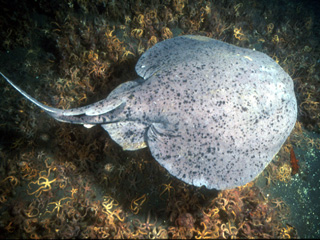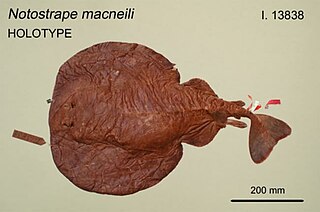
The electric rays are a group of rays, flattened cartilaginous fish with enlarged pectoral fins, composing the order Torpediniformes. They are known for being capable of producing an electric discharge, ranging from 8 to 220 volts, depending on species, used to stun prey and for defense. There are 69 species in four families.

Tetronarce californica also known as the Pacific electric ray is a species of electric ray in the family Torpedinidae, endemic to the coastal waters of the northeastern Pacific Ocean from Baja California to British Columbia. It generally inhabits sandy flats, rocky reefs, and kelp forests from the surface to a depth of 200 m (660 ft), but has also been known to make forays into the open ocean. Measuring up to 1.4 m (4.6 ft) long, this species has smooth-rimmed spiracles and a dark gray, slate, or brown dorsal coloration, sometimes with dark spots. Its body form is typical of the genus, with a rounded pectoral fin disc wider than long and a thick tail bearing two dorsal fins of unequal size and a well-developed caudal fin.

Tetronarce fairchildi, commonly known as the New Zealand torpedo, is a species of electric ray of the family Torpedinidae found only around New Zealand, at depths of between 5 and 1,100 m. This species is placed in the genus Tetronarce.

Torpedo is a genus of rays, commonly known as electric rays, torpedo rays, or torpedoes. They are slow-moving bottom-dwellers capable of generating electricity as a defense and feeding mechanism.

Narcine is a genus of electric rays in the family Narcinidae. These species have a rounded pectoral fin disc and two dorsal fins, the first usually smaller than the second and placed behind the pelvic fin bases. The tail is longer than the disc and has a lateral fold. The spiracles are close behind the eyes, the nasal flaps are merged into a flap in front of the mouth. The teeth are nearly flat, with a central point.

The Florida torpedo is a rare and little-known species of electric ray in the family Torpedinidae. It is known only from two specimens and a some wild sightings. Torpedoes have been recorded from three scattered locations in the Florida Straits and the western Caribbean Sea, and appear to inhabit coral habitats.

The black-spotted torpedo is a poorly known, uncommon species of electric ray in the family Torpedinidae, known for being capable of generating an electric shock. It is endemic to southern Africa and possibly several small Indian Ocean islands, although the latter reports may represent undescribed new species. Its appearance is similar to the Gulf torpedo, but it is duller in coloration.

Torpedo panthera also known as the leopard torpedo or panther electric ray is a species of fish in the family Torpedinidae. It is found in Djibouti, Egypt, Eritrea, India, Iran, Oman, Pakistan, Saudi Arabia, Somalia, Sudan, and Yemen. It is reported in the northern Indian Ocean, including the Red Sea, the Gulf of Aden, the Sea of Oman, and the Persian Gulf. Its natural habitat is open seas.
Tetronarce puelcha, commonly known as the Argentine torpedo, is a species of fish in the family Torpedinidae. It is found in Argentina, Brazil, and Uruguay. Its natural habitat is open seas. It is rare electric ray fish species, which is moderately large (104 cm) found in South West Atlantic.

The Gulf torpedo or variable electric ray, is a species of electric ray in the family Torpedinidae. It is found in the Indian Ocean, but may represent a species flock of several local endemic species. It is distinguishable from other Torpedo species in its range by its ornate dorsal coloration. Another common name, marbled electric ray, is not to be confused with Torpedo marmorata.

The marbled electric ray is a species of electric ray in the family Torpedinidae found in the coastal waters of the eastern Atlantic Ocean from the North Sea to South Africa. This benthic fish inhabits rocky reefs, seagrass beds, and sandy and muddy flats in shallow to moderately deep waters. It can survive in environments with very little dissolved oxygen, such as tidal pools. The marbled electric ray has a nearly circular pectoral fin disc and a muscular tail that bears two dorsal fins of nearly equal size and a large caudal fin. It can be identified by the long, finger-like projections on the rims of its spiracles, as well as by its dark brown mottled color pattern, though some individuals are plain-colored. Males and females typically reach 36–38 cm (14–15 in) and 55–61 cm (22–24 in) long respectively.
Tetronarce tremens, commonly known as the Chilean torpedo, is a species of fish in the family Torpedinidae. It is found in Chile, Colombia, Costa Rica, Ecuador, and Peru. Its natural habitat is open seas.

Members of the family Narkidae are commonly known as sleeper rays. They are restricted to the temperate and tropical Indo-West Pacific from South Africa to Japan to Indonesia, and are exclusively marine and are absent from freshwater habitats. They occur from the intertidal zone to the continental shelf and the upper continental slope to a depth of 350 meters, favoring soft-bottomed habitats.

The common torpedo, also known as ocellate torpedo or eyed electric ray, is a species of electric ray in the family Torpedinidae. It is found in the Mediterranean Sea and the eastern Atlantic Ocean from the Bay of Biscay to Angola, and is a benthic fish typically encountered over soft substrates in fairly shallow, coastal waters. Growing to 60 cm (24 in) long, this species has a nearly circular pectoral fin disc and a short, thick tail with two dorsal fins of nearly equal size and a large caudal fin. It can be identified by the prominent blue spots on its back, which usually number five but may vary from zero to nine, as well as by the small knobs on the rims of its spiracles.

The Atlantic torpedo is a species of electric ray in the family Torpedinidae. It is found in the Atlantic Ocean, from Nova Scotia to Brazil in the west and from Scotland to West Africa and off southern Africa in the east, occurring at depths of up to 800 m (2,600 ft), and in the Mediterranean Sea. Younger individuals generally inhabit shallower, sandy or muddy habitats, whereas adults are more pelagic in nature and frequent open water. Up to 1.8 m (6 ft) long and weighing 90 kg (200 lb), the Atlantic torpedo is the largest known electric ray. Like other members of its genus, it has an almost circular pectoral fin disk with a nearly straight leading margin, and a robust tail with a large triangular caudal fin. Distinctive characteristics include its uniform dark color, smooth-rimmed spiracles, and two dorsal fins of unequal size.

The Japanese sleeper ray is a species of electric ray in the family Narkidae. It is common in the inshore and offshore waters of the northwestern Pacific Ocean from southern Japan to southern China. Growing up to 40 cm (16 in) long, the Japanese sleeper ray has a nearly circular pectoral fin disc colored reddish to chocolate brown above, sometimes with darker or lighter spots, and lighter brown below. The spiracles behind its small eyes have raised, smooth rims. Its short and muscular tail bears a single dorsal fin positioned aft of the rounded pelvic fins, and terminates in a large caudal fin.

Tetronarce is a genus of rays, commonly known as electric rays. They are slow-moving bottom-dwellers capable of generating electricity as a defense and feeding mechanism. Tetronarce species tend to attain a much larger size than Torpedo species, which are usually small to moderate sized electric rays.

Tetronarce macneilli, commonly known as the shorttail torpedo, is a species of large electric ray. The taxonomy of the species has been long debated and has been suggested that it is synonymous with Torpedo fairchildi.















